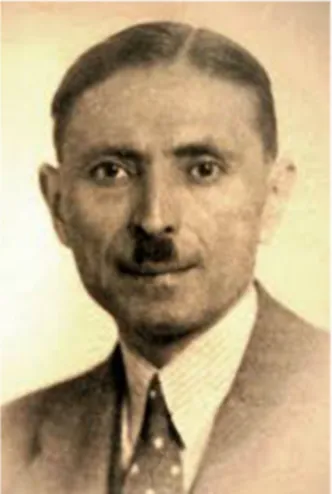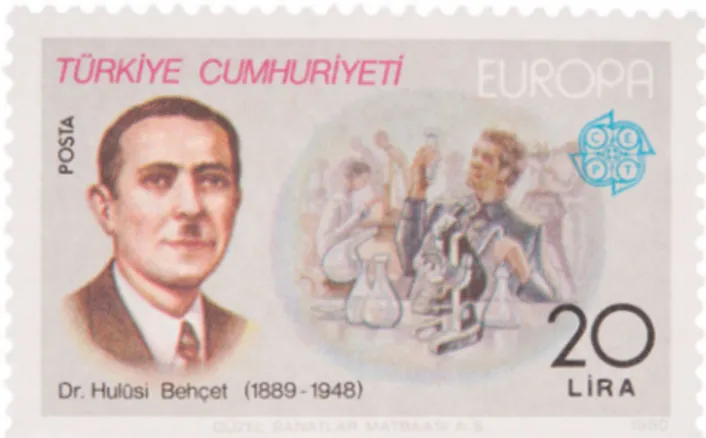COVER EDITORIAL
Turkish scientist Hulusi Behçet (1889
–1948) and his
contribution to the medical world
Yaşar B. Turgut1&Mehmet Turgut2
Received: 25 January 2019 / Accepted: 29 January 2019
# Springer-Verlag GmbH Germany, part of Springer Nature 2019
Biography of Hulusi Behçet (1889
–1948)
Hulusi Behçet was born in Istanbul, the capital of the Ottoman Empire, on 20 February 1889 [1, 2]. He was raised by his grandmother as he lost his mother while he was a child. He went to Damascus because of his father’s duties and graduated primary school with French, Latin, and German languages [2]. In 1914, Behçet completed his training in dermatology and venereal diseases at Gulhane Military Medical Academy in Istanbul [2]. Then, he worked at Edirne, Haskoy, and Guraba Hospitals and moved to Budapest and then to Charité Hospital in Berlin [2]. Following the institution of the Republic of Tu r k e y, B e h ç e t w a s a p p o i n t e d p r o f e s s o r o f t h e Department of Dermatology and Venereal Diseases in 1933 and he published almost 140 scientific papers, about 20 medical translations, and two medical books (Fig. 1) [2]. He was described as a shy and introverted but joyful and good-humored man, though he suffered from ill health due to insomnia, spastic colitis, and angina pectoris [2]. Lastly, he suddenly died from a heart attack in 1948, at the age of 59 [2].Description of Behçet
’s disease or syndrome
by Hulusi Behçet
Clasically, the famous disease that bears his name—Behçet’s disease or syndrome—has taken roots from his Bthree patients,^ which were examined by Hulusi Behçet: The first patient had been investigated by many physicians in Istanbul and Vienna without any diagnosis; then, the patient had be-come blind by the time he visited Behçet in 1924; The second patient was a woman with similar complaints composed of recurrent lesions in her mouth, eyes, and genital regions at the time she visited Behçet in 1930; and the third patient had fever and abdominal pain in addition to the findings of the second patient when observed by Behçet in 1936 [2]. Based on his clinical experiences from these patients, Behçet as-cribed the signs and symptoms, known as traditional BBehçet’s triad^, to a new, single, and specific disease, a pos-sible result of viral infection [2]. Then, many authors from the the USA, Japan, Israel, and some countries in Europe began to report similar cases following publication of his exotic cases in an international journal in 1937 [2, 3]. In 1947, Alfred
Fig. 1 Photograph of Dr. Hulusi Behcet (1889–1948) (fromen. wikipedia.org) * Mehmet Turgut drmturgut@yahoo.com Yaşar B. Turgut barroturgut@hotmail.com 1
Department of Internal Medicine, Muğla Sıtkı Koçman University School of Medicine, 48000 Muğla, Turkey
2 Department of Neurosurgery, Adnan Menderes University School of Medicine, 09100 Aydın, Turkey
https://doi.org/10.1007/s00381-019-04081-8
Child's Nervous System(2020) 36:665–666
Guido Miescher (1887–1961), professor and chief of the University Dermatology Clinic in Zurich, suggested that the disease should be calledBMorbus Behçet^ (Behçet’s disease) at the International Congress of Dermatology in Geneva, Italy [2]. Today, Hulusi Behçet is the most famous figure of the modern Turkish medical school (Fig.2and cover).
Behçet’s disease or syndrome, is an autoimmune vasculitis characterized by oral and genital ulcerations, uveitis, and
involvement of the skin, joints, intestinal tract, blood vessels, and, in some cases, the central nervous system, with remis-sions and exacerbations in cases living in the Middle East and Central Asia [1,2]. Even today, diagnosis and therapy of the disease is still challenging for pediatric neurologists and neu-rosurgeons because of its rarity and non-specific presentation in childhood [1].
Compliance with ethical standards
Conflict of interest The authors have no conflicts of interest to disclose. Publisher’s note Springer Nature remains neutral with regard to jurisdic-tional claims in published maps and institujurisdic-tional affiliations.
References
1. Nanthapisal S, Klein NJ, Ambrose N, Eleftheriou D, Brogan PA (2016) Paediatric Behçet’s disease: a UK tertiary centre experience. Clin Rheumatol 35:2509–2516
2. Tan SY, Poole PS (2016) Hulusi Behçet (1889–1948): passion for dermatology. Singap Med J 57:408–409
3. Behçet H (1937) Über rezidivierende, aphtöse, durch ein Virus verursachte Geschwüre am Mund, am Auge und an den Genitalien. Dermatol Wochenschr 105:1152–1163
Fig. 2 and cover Turkish stamp depicting Hulusi Behçet, Europa CEPT, 1980 (Reprinted from the original copy of the stamp with the written permission of the Republic of Turkey Ministry of Transport and Infrastructure the General Directorate of Postal Affairs, Stamp Museum, Ankara, Turkey)
Childs Nerv Syst (2020) 36:665–666

